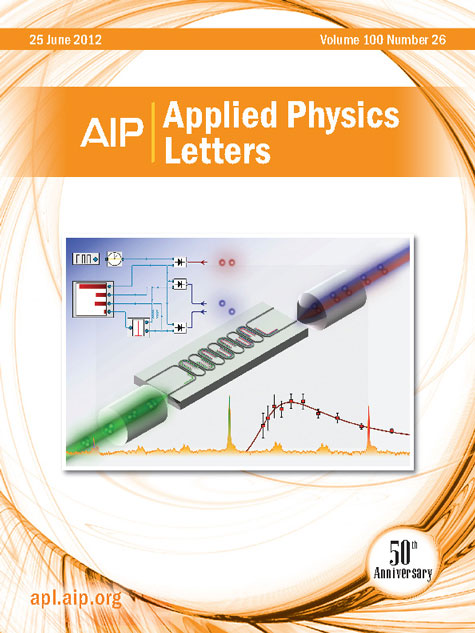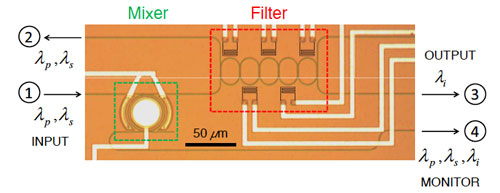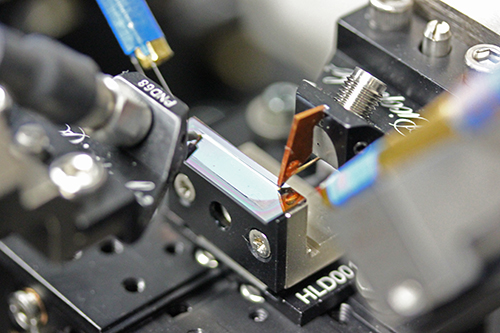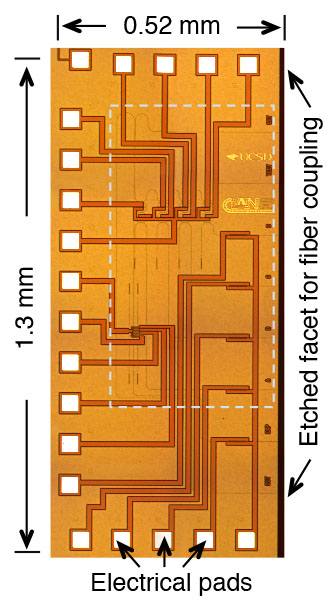Quantum photonics

In 2012, we demonstrated telecommunications-band heralded single photons from a CMOS-compatible silicon nanophotonic chip [APL 2012]. The chip operated at room temperature (uncooled) and is optically pumped with a few milliwatts of pump power at 1550 nm, easily available from laser diodes. In [OpEx 2013], we described an analytical and computational method for calculating the pair-generation properties of such devices, including the joint spectral intensity (JSI) of the Stokes and anti-Stokes photons. In [Nature Comm 2014] we experimentally demonstrated different JSI's generated by a silicon chip, and in [Opt. Express 2015], verified that they have different degrees of entanglement as measured by unfolded and folded Franson interferometry.
We have shown pair generation from Si microring resonators, including the use of a small amount (microwatts) of pump power [Opt. Express 2016], and monitoring the microring resonance using an in-built Si p-i-n diode which enables microring pair generation over 40°C range of temperature variation [APL 2015].
"Silicon photonic entangled photon-pair and heralded single photon generation with CAR > 12,000 and g(2)(0) < 0.006" Optics Express Vol. 25, No. 26, pp. 32995-33006 (2017). [URL]
"High Quality Entangled Photon Pair Generation in Periodically Poled Thin-Film Lithium Niobate Waveguides" Physical Review Letters 124, 163603 (2020). [URL]
Nonlinear optics using silicon photonics
A new generation of deployable optical signal processing and communications devices can be made if we can demonstrate CMOS-compatible chip-scale devices which can perform ultrafast wavelength conversion of 1-1000 GHz bandwidth signals using as little pump power as possible, e.g., directly from an unamplified laser diode. This research involves optical dispersion engineering, electronic carrier management, and in some cases, thermo-optic tuning.

Using reverse-biased silicon microrings, CW four-wave mixing conversion efficiency of -13.4 dB is achieved using 20 um radius micro-ring resonators with only 2.5 mW pump power [IEEE PTL 2013]. Silicon rib waveguides (passive loss of 0.74 dB/cm) with free-carrier lifetime reduction via reverse biased PIN diodes show CW four-wave mixing efficiency of -8.2 dB (-4.4 dB if both signal and idler are measured at the output) with 160 mW pump power (about 2X reduction compared to other reports in literature) [CLEO 2013].
We have improved the wavelength conversion efficiency of slow-light enhanced FWM in silicon Coupled-Resonator Optical Waveguides by 20 dB from our earlier report in [Opt. Lett. 2011] to our recent report in [Opt. Lett. 2014], showing 10 Gbps NRZ eyes for the first time.
Tunable higher-order microring filters were integrated on the same chip as a carrier-swept ring mixer, to separate the generated idler wavelength from the residual pump and unconverted signal [Opt Lett 2014].
Silicon waveguides can be used as a compact source of longer wavelength (2.4 um) infrared light via four-wave mixing in conjunction with fiber-optical seed sources [Nat Photon 2010].
Hybrid Silicon - Lithium Niobate photonics

This research focuses on bringing lithium niobate films-on-insulator (LNOI) to the foundry-fabricated silicon-on-insulator (SOI) platform. This is done by fabricating bonded SOI-LNOI integrated devices with do not require etching of the LN film. The design and fabrication process mitigates thermal stresses in the bonded stack. This technology can enable compact diode/transistor-controlled devices in LN photonics, and efficient wavelength converters and electro-optic modulators in Si photonics, both of which are unattainable with each standalone traditional photonics platform.
"Thin-film Lithium Niobate Electro-optic Modulators: To Etch or Not To Etch" Applied Physics Letters 122, 120501 (2023). [URL]
"Towards 3D Integrated Photonics using Lithium Niobate Thin Films" IEEE Nanotechnology Magazine Vol. 13, No. 4, 18-33 (2019). [URL]
"A Modular Fabrication Process for Thin-film Lithium Niobate Modulators with Silicon Photonics" Journal of Physics: Photonics, Vol. 4, 024001 (2022). [URL]
Silicon photonics in data centers

Silicon photonic microring and microdisc modulators are widely used because of their wavelength selectivity and low electrical power consumption. However, an important limitation of these devices is their ability to handle high optical powers. We experimentally studied how to achieve a record high optical modulation amplitude (OMA), which can increase the range of unamplified short-distance optical communications.
"High-speed silicon microresonator modulators with high optical modulation amplitude (OMA) at input powers >10 mW" Optics Express Vol. 30, No. 5, 6826-6837 (2022). [URL]
We demonstrated microsecond cross-bar switching of twenty wavelength channels of the [MORDIA] microsecond-scale circuit-switched data-center ring network. Each of the wavelengths carried 10 Gbit/second server-generated data. We used a digital driver for the heater, in which pulse width was controlled, rather than dc amplitude [Optics Express 2014].
In a post-deadline paper at the [2014 IEEE Photonics Conference], we demonstrated a compact silicon photonic chip (1.30 mm x 0.52 mm) that integrates electrically-tunable 4-channel add, drop and power control functionalities with low power consumption for a research-category WDM data-center network.







